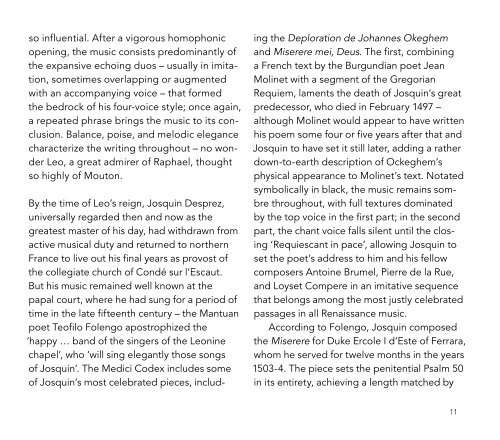Sie wollen auch ein ePaper? Erhöhen Sie die Reichweite Ihrer Titel.
YUMPU macht aus Druck-PDFs automatisch weboptimierte ePaper, die Google liebt.
so influential. After a vigorous homophonic<br />
opening, the music consists predominantly of<br />
the expansive echoing duos – usually in imitation,<br />
sometimes overlapping or augmented<br />
with an accompanying voice – that formed<br />
the bedrock of his four-voice style; once again,<br />
a repeated phrase brings the music to its conclusion.<br />
Balance, poise, and melodic elegance<br />
characterize the writing throughout – no wonder<br />
Leo, a great admirer of Raphael, thought<br />
so highly of Mouton.<br />
By the time of Leo’s reign, Josquin Desprez,<br />
universally regarded then and now as the<br />
greatest master of his day, had withdrawn from<br />
active musical duty and returned to northern<br />
France to live out his final years as provost of<br />
the collegiate church of Condé sur l’Escaut.<br />
But his music remained well known at the<br />
papal court, where he had sung for a period of<br />
time in the late fifteenth century – the Mantuan<br />
poet Teofilo Folengo apostrophized the<br />
‘happy … band of the singers of the Leonine<br />
chapel’, who ‘will sing elegantly those songs<br />
of Josquin’. The Medici Codex includes some<br />
of Josquin’s most celebrated pieces, includ-<br />
ing the Deploration de Johannes Okeghem<br />
and Miserere mei, Deus. The first, combining<br />
a French text by the Burgundian poet Jean<br />
Molinet with a segment of the Gregorian<br />
Requiem, laments the death of Josquin’s great<br />
predecessor, who died in February 1497 –<br />
although Molinet would appear to have written<br />
his poem some four or five years after that and<br />
Josquin to have set it still later, adding a rather<br />
down-to-earth description of Ockeghem’s<br />
physical appearance to Molinet’s text. Notated<br />
symbolically in black, the music remains sombre<br />
throughout, with full textures dominated<br />
by the top voice in the first part; in the second<br />
part, the chant voice falls silent until the closing<br />
‘Requiescant in pace’, allowing Josquin to<br />
set the poet’s address to him and his fellow<br />
composers Antoine Brumel, Pierre de la Rue,<br />
and Loyset Compere in an imitative sequence<br />
that belongs among the most justly celebrated<br />
passages in all Renaissance music.<br />
According to Folengo, Josquin composed<br />
the Miserere for Duke Ercole I d’Este of Ferrara,<br />
whom he served for twelve months in the years<br />
1503-4. The piece sets the penitential Psalm 50<br />
in its entirety, achieving a length matched by<br />
11


